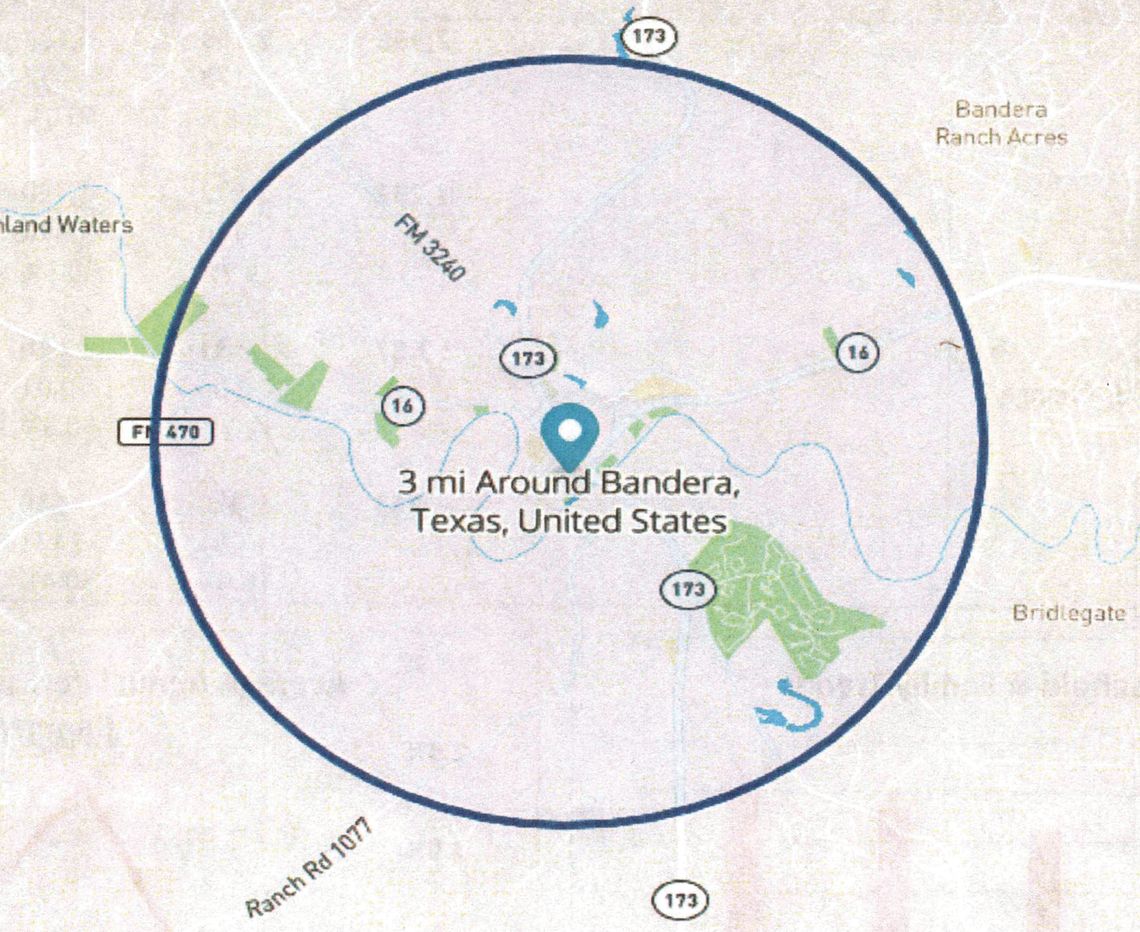A new demographic study commissioned by the Episcopal Diocese of West Texas reveals a growing and evolving community in the area around Bandera.
The report, released March 7, provides an indepth look at population trends, household dynamics and various socio-economic factors shaping the region.
Population Growth Outpaces State Average
The study, which focuses on a 3-mile radius around Bandera, indicates that the area’s population is expanding at a slightly faster rate than the state of Texas overall.
The estimated 2023 population within the study area is 4,121, and projections suggest this number will climb to 4,356 by 2028.
This represents a 5.7% growth rate for the area, compared to the state’s projected growth of 5.5% over the next five years.
The average annual change rate for the study area is estimated at 1.1%.
Household Dynamics: Smaller but Growing
While the population is on the rise, the study also highlights interesting trends in household composition.
Households within the study area are growing at a faster pace than the population, leading to a slight decrease in the average population per household.
In 2010, the average population per household was 2.31, and this is projected to be 2.30 by 2028. This contrasts with the statewide average of 2.82 persons per household.
The report suggests that the increasing population per household is likely due to additional children, as family households are growing at the same rate as the population.
Racial and Ethnic Trends: Stability Projected
The study also provides a detailed breakdown of the racial and ethnic composition of the study area.
The analysis considers five groups: Asian (Non-Hispanic), Black/African American (Non-Hispanic), White (Non-Hispanic), Hispanic or Latino and a combined category for Pacific Islander/American Indian/ Other (Non-Hispanic).
The racial-ethnic makeup of the area is projected to remain relatively stable over the next five years.
• The percentage of Asian (Non-Hisp) residents is projected to remain around 0.23%.
• The percentage of Black/African American (Non-Hisp) residents is projected to remain around 0.41%.
• The percentage of White (Non-Hisp) residents is projected to remain around 77%.
• The percentage of Hispanic or Latino residents is projected to remain around 19%.
Aging Population Trend
An important aspect of the report is the analysis of age trends within the community. The study area’s population is aging, with the average age increasing over the past few years.
The average age in the study area was 41.61 in 2000, 45.15 in 2010, and is estimated to be 46.01 in 2023. It is projected to be 45.55 in 2028 and 44.52 in 2033.
This trend is notable when compared to the average age in Texas, which is lower. The average age in Texas is estimated to be 37.32 in 2023, and projected to be 38.02 in 2028.
The report also breaks down the population into seven “phases of life,” providing a more detailed look at the age distribution.
School-Aged Children: A Closer Look
Given the importance of planning for social and educational services, the report includes a specific analysis of school-aged children. This segment is a subset of the “Required Formal Schooling” category in the Phase of Life profile.
The study divides school-aged children into three levels:
• Early Elementary (ages 5 to 9)
• Late Elementary/ Middle School (ages 10 to 14)
• High School (ages 15 to 17) The findings indicate a potential resurgence of younger children in the area. Early Elementary children are projected to increase as a percentage of children between 5 and 17, while Late Elementary/Middle School aged children are declining.
Income Trends: Household Income on the Rise
The report also examines income trends within the study area, focusing on average household income and per capita income.
The estimated current year average household income is $88,471, and it is projected to grow by 13.8% to $100,637 by 2028.
Per capita income, the average income of all persons within a household, is estimated at $38,428 for the current year and is projected to increase by 13.9% to $43,757 by 2028.
Further analysis delves into the distribution of household income, revealing shifts in income brackets over time.
Family Income: Above $100,000 Decline Projected
In a subset analysis of family income (excluding non-family households), the report projects a slight decline in the number of families with annual incomes above $100,000 over the next five years.
Currently, it is estimated that 39.5% of all family incomes exceed $100,000 per year, with a projected decrease to 39.3% in five years.
Median Income by Race and Ethnicity: Wide Disparity
The study also breaks down median income by race and ethnicity, highlighting disparities among different groups.
• Asian Household Income: $37,499
• Black/African American Household Income: $183,332
• Hispanic/Latino Household Income: $45,576
• White/Anglo Household Income: $74,359
• Pacific Islander, American Indian, Other Household Income: $29,791 The average median household income for the area is $74,111.
Households with Children: Changing Dynamics
The report examines the diversity of child-rearing environments, specifically focusing on family households with children under 18. It distinguishes between:
• Married couple families
• Single-parent families The data indicates a shift in household structure, with married couple households with children decreasing as a percentage, while single- parent households with children are increasing.
Marital Status: More Married, More Divorced Than State Average
An analysis of marital status reveals that adults in the study area are more likely to be married than the state average.
However, the percentage of single, never-married individuals is lower than the state average, and divorce is more prevalent.
The report also provides a breakdown of marital status by gender.
Educational Attainment: High School Graduates Dominate
The study examines the educational attainment of adults in the area, revealing that a significant portion has a high school diploma.
• Less than 9th Grade: 3.2%
• 9th to 12th Grade, No Diploma: 4.6%
• High School Graduate: 31.6%
• Some College, No Degree: 21.6%
• Associate’s Degree: 8.4% • Bachelor’s Degree: 18.8%
• Graduate Degree: 11.8%
Employment and Occupations: White Collar Growth
The report provides insights into employment and occupation trends, indicating a shift towards white-collar jobs.
• White Collar Occupations: 56.2% in 2023, projected to be 57.5% in 2028
• Blue Collar Occupations: 32.6% in 2023, projected to be 31.2% in 2028
• Not in the Labor Force: 31.2% in 2023 and 2028






.png)
